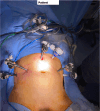Salvage robotic-assisted radical cystectomy is safe in patients with history of pelvic irradiation
- PMID: 40765535
- PMCID: PMC12321446
- DOI: 10.1097/CU9.0000000000000279
Salvage robotic-assisted radical cystectomy is safe in patients with history of pelvic irradiation
Abstract
Objectives: To describe the surgical approach and perioperative outcomes of a multicenter series evaluating a robotic-assisted approach to radical cystectomy with total intracorporeal urinary diversion in the setting of prior pelvic radiotherapy.
Materials and methods: We analyzed our prospective cystectomy database for patients who underwent robotic-assisted radical cystectomy for bladder cancer after radiotherapy between 2018 and 2022. Demographic information and data regarding preoperative factors including stage of disease, preoperative hydronephrosis, and history of pelvic radiotherapy were collected via review of electronic medical records. All operations were performed by 1 of 2 experienced urologists using the da Vinci X, Xi, or Si surgical platforms.
Results: Ten patients were identified for this study. The median age of participants was 73.5 years (range, 41-84 years). The median American Society of Anesthesiologists classification score was 3 (range, 3-4). The median Charlson Comorbidity Index was 6 (range, 2-12). Among the patients, 4 out of 10 patients (40%) had muscle invasive bladder cancer before salvage surgery. Intracorporeal ileal conduit urinary diversion was performed in 8 patients, whereas 2 patients underwent intracorporeal neobladder formation. Median intraoperative blood loss was 250 mL (range, 150-600 mL), and median operative duration was 390 minutes (range, 195-450 minutes). The overall 30-day complication rate was 60% with a Clavien-Dindo grade ≥3 complication rate of 15%. Perioperative mortality was 0%. Median duration of follow-up was 210 days (range, 60-1580 days).
Conclusions: This series describing the outcomes of salvage robotic-assisted radical cystectomy using total intracorporeal urinary diversion demonstrates the safety of this technique. Further studies with long-term follow-up, including oncological outcomes, are required to support the widespread adoption of this procedure.
Keywords: Bladder cancer; Ileal conduit; Intracorporeal urinary diversion; Neobladder; Radiotherapy; Robotic-assisted radical cystectomy; Salvage.
Copyright © 2025 The Authors. Published by Wolters Kluwer Health, Inc.
Conflict of interest statement
No member of the authorship has any significant disclosures to make regarding this manuscript, nor were any financial incentives gained through the writing of this manuscript or possible future publication.
Figures



Similar articles
-
Robot-assisted supratrigonal cystectomy and augmentation cystoplasty for adult neurogenic lower urinary tract dysfunction: comparison of extracorporeal versus intracorporeal diversion.Ther Adv Urol. 2025 Jul 25;17:17562872251359339. doi: 10.1177/17562872251359339. eCollection 2025 Jan-Dec. Ther Adv Urol. 2025. PMID: 40735192 Free PMC article.
-
Systematic review and cumulative analysis of perioperative outcomes and complications after robot-assisted radical cystectomy.Eur Urol. 2015 Mar;67(3):376-401. doi: 10.1016/j.eururo.2014.12.007. Epub 2015 Jan 2. Eur Urol. 2015. PMID: 25560798
-
Systematic review comparing uretero-enteric stricture rates between open cystectomy with ileal conduit, robotic cystectomy with extra-corporeal ileal conduit and robotic cystectomy with intra corporeal ileal conduit formation.J Robot Surg. 2024 Feb 28;18(1):100. doi: 10.1007/s11701-024-01850-9. J Robot Surg. 2024. PMID: 38413496 Free PMC article.
-
Supratrigonal systectomy: last line treatment for radiation-induced hemorrhagic cystitis.Arch Ital Urol Androl. 2025 Jun 30;97(2):13492. doi: 10.4081/aiua.2025.13492. Epub 2025 May 26. Arch Ital Urol Androl. 2025. PMID: 40420732
-
Systematic review of the oncological and functional outcomes of pelvic organ-preserving radical cystectomy (RC) compared with standard RC in women who undergo curative surgery and orthotopic neobladder substitution for bladder cancer.BJU Int. 2017 Jul;120(1):12-24. doi: 10.1111/bju.13819. Epub 2017 Mar 24. BJU Int. 2017. PMID: 28220653
References
-
- Hautmann RE, de Petriconi R, Volkmer BG. Neobladder formation after pelvic irradiation. World J Urol 2009;27(1):57–62. - PubMed
-
- Al Hussein Al Awamlh B Nguyen DP Otto B, et al. The safety of robot-assisted cystectomy in patients with previous history of pelvic irradiation. BJU Int 2016;118(3):437–443. - PubMed
-
- Piazza P Rosiello G Chacon VT, et al. Robot-assisted cystectomy with intracorporeal urinary diversion after pelvic irradiation for prostate cancer: Technique and results from a single high-volume center. Eur Urol 2021;80(4):489–496. - PubMed
LinkOut - more resources
Full Text Sources
